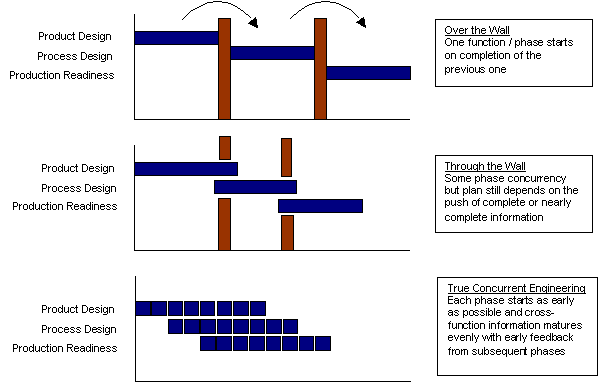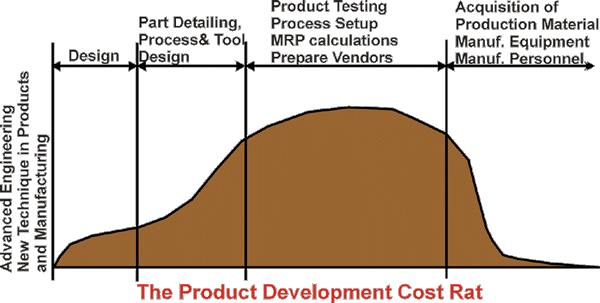Pre Production Parts Planning (PPPP)
In the ”good old days” we planned Product Development according to the ”waterfall method”, i.e. the previous step in the development chain had to be ready before the consecutive step could start. To-day we need Concurrent Engineering, meaning that we want to work in parallel as much as possible with lots of collaboration between the various departments and groups with different professions and skills.
Here are three presentations on how other companies view Concurrent Engineering:
 Concurrent Engineering is important due to several factors.
Concurrent Engineering is important due to several factors.
Here are a few:
- When you shorten the overall time from Project start to first new Product down the manufacturing line, you save money and gaine time to market at the same time.
- You will get much earlier signals back to Product Engineering about manufacturing problems and unexpeced costs and hence, you will be able to make necessary changes before you have tied up too much capital.
- Etc.
 It is enough just to take a look at the ”Cost Rat” to realize that it is in the early phases of the Product Development Process that you define what will cost all the money in Tools, Machines, Logistics and in the Manufacturing Process later. The more accurate you can define the Product and the Manufacturing Process up front, the more money you will be able to save later.
It is enough just to take a look at the ”Cost Rat” to realize that it is in the early phases of the Product Development Process that you define what will cost all the money in Tools, Machines, Logistics and in the Manufacturing Process later. The more accurate you can define the Product and the Manufacturing Process up front, the more money you will be able to save later.
Let us first have a look at the Players in the Product Development Process
Product Engineering
- Product Planning where the requirements of properties and performance of the Products are being defined
- Product Development Engineering where the geometries and the properties of the Products are being developed and documented
- The Prototype Workshop where physical prototypes are being built.
- The Laboratory and Test Grounds where the Products are being tested.
- The Engineering Calculation Group where virtual prototypes are being created, calculated and ”tested”.
- The Engineering Planning and Economy Group who plan for resources, costs and time.
- The Standards Department where standards regarding Hardware and Software in the Products are being defined.
- and there may be a few more
Manufacturing Engineering
- Manufacturing Planning who takes care of planning for when new models and Engineering Changes shall be effected. Also plans for changes needed in the factory to be able to manufacture Products planned.
- Order Handling and hour-to-hour and day-to-day planning of the manufacturing.
- Manufacturing Engineering where manufacturing methods and processes are developed and documented.
- Maintenance of the manufacturing facilities
- Material logistics is an important factor of the Material Requirements Planning which is normally done in a mechanized way but with some human intelligence and intuition.
- Quality Management is keeping an eye on the Quality Index which they are responsible for the definition of.
- Manufacturing Economy where the bookkeeping is done and who chases possible savings everywhere.
- and there may be a few more.
Purchasing
Manufacturing Planning who have the contact with vendors and external partners. They have to evaluate vendors from quality, price and performance viewpoints and assist vendors in finding best manufacturing techniques etc.
Customer Support
- Parts Catalogues should be ready when manufacturing of the new Products starts.
- The whole Service Organization have to be ready to support customers with ESW problems as soon as they get the new Products.
- Spare Parts Stock and Parts Logistics has to be ready before the new Products hit the market.
- Etc.
Marketing
- Analyze and decide on which Options to sell on which Markets and update the Sales Configurator based on Engineering Configuration Rules and Marketing Policies.
- Decide on prices and create price lists
- create Promotion documentation and write Press Releases etc.
And a few more – – –
will have to to do a lot before they can sell the first new Product. Things have to be prepared before manufacturing of the new Product starts.
All personnel working with these different lines of work should work together, collaborate, and there should be a plan covering when they should do what. Normally this calls for a general plan that is broken down to several local plans per organizational unit with carefully defined Decision Points or Gates that the process cannot pass unless a set of specified criteria is fulfilled.
New Parts.
Nobody misses the Project Time Plan but the most time critical object in this plan is ”New Parts”, i.e. the Parts that are new to the project and have to be developed, need MRP planning, need new tools and/or NC-programming, etc. It is therefore smart to concentrate on planning the New Parts specifically. One way is to assign a Part Ready Status around which the planning should be done, for instance:
Part Ready Status A is applied for Parts and Parts Documentation released for
- building Prototypes
- early information to Manufacturing Engineering in order to get a feedback with their aspects
- early information for evaluation of Buy/Make distribution.
Part Ready Status B is applied for Parts and Parts Documentation released for Manufacturing Tool Engineering, Preliminary MRP Calculations, Logistics, Blank Design etc.
Part Ready Status C is applied for Parts and Parts Documentation released for acquisition of Manufacturing Tools, ordering of Manufacturing Machines, purchase of Raw Materiel etc
.
Part Ready Status P is applied for parts and Parts Documentation released for Serial Manufacturing, full scale.
The definition of a Part Ready Status can of course be different for different types of industries. The processes and needs may vary and several more types of requirements can be attached to the Part Ready Status.
For each New Part, or Part to be treated as a New Part, there should be a plan for when the Part Documentation should be released for each Part Ready Status:
Planned Date, Committed Date, Actually Confirmed Date given per New Part. This will give Manufacturing Engineering (and other departments) a chance to plan their workload and activities with a little more accuracy provided Product Engineering is committed to promised release dates.
- PPPP will save a lot of money and it will provide support for Concurrent Engineering in a tremendous way when you can plan the New Parts individually according to the Lead Time for individual New Parts calculated backwards from the date when the Parts have to be ready for Serial Manufacturing.It does not take a very complicated application to do this. I believe, the functionality may be added to almost any PDM application with very small costs and efforts. However, it may take some effort to convince all people thoughout the organization who should use the functionality offered and get them enthused in maximizing the benefits possible.
- The worst part may be to get Product Engineering to really commit to their planned delivery time (releases) of the Documentation related to the different Part Ready Statuses. It may also prove difficult to make Product Engineering understand that their commitment to plan their delivery of Documentation according to Lead Time per Part is so critical.
- The problem is that people are used to work according to the Project Time Schedule regardless of the different Part’s Lead Time to Manufacturing.
- I have only touched on the relation to Manufacturing here but there are of course similar relations to all the other areas. They will also benefit from a well managed PPPP.
- I can relate to a proposal for the development of an application for PPPP for Volvo CE in 1991. The total cost was calculated to KSEK 862 (about € 100.000) with a very high profitability (pay-off after 0.43 years). However, it was turned down with reference to the hard times that hit the industry that year, but the real reason, I believe, was the obvious commitment to release dates that the Product Engineering would have to meet and which they tried their best to avoid.
A successful PPPP will call for direct support by top management and a set of agreed conventions, well defined processes and some computer applications.
PPPP is part of Concurrent Engineering and this is primarily a way to plan and manage the extended Product Development Process.
